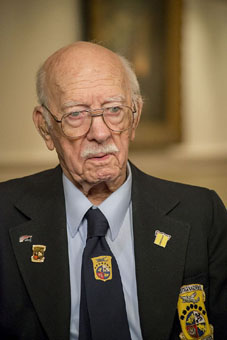
in this U.S. Navy photo, Saylor answers questions at a luncheon in Washington, D.C. last week.
Remembering Doolittle's Raiders
By Earl H. Perkins | re-published Tuesday, November 11, 2014 |
Thursday Review Associate Editor
Off we go into the wild blue yonder,
Climbing high into the sun
Here they come zooming to meet our thunder
At 'em boys, Give 'er the gun!
The Army Air Corps song(later becoming the official song of the U.S. Air Force)
At one time they were the toast of the world, 80 strong when they volunteered for a dangerous mission, but now four of Jimmy Doolittle's Tokyo Raiders remain, according to an Associated Press story.
Only three of those men, all in their 90s, were able to attend a reunion ceremony in November 2013, where they toasted their fallen comrades. It was held at the National Museum of the U.S. Air Force near Dayton, Ohio, with a crowd of hundreds witnessing the Raiders each call out "here" as a historian read the names of every airman.
"May they rest in peace," said Lt. Col. Richard Cole, 98, as the airmen sipped 1896 cognac from specially engraved silver goblets. Doolittle, an American aviation pioneer who was born in 1896, had set the bottle aside many years ago for just such an occasion. The other two men able to attend the reunion were Edward Saylor and David Thatcher.
They and 77 other Raiders volunteered for a top-secret mission they knew nothing about, changing the world forever as they flew into history on April 18, 1942.
The Japanese Imperial Army had been overrunning China throughout the 1930s, aiming to extend their reach across the Far East and to North America.
Japan devastated the American Pacific Fleet with its bombing of Pearl Harbor on December 7, 1941, simultaneously attacking the Philippines and Malaysia.
The U.S. declared war on Japan, but our weakened fighting forces took heavy losses as Imperial Japanese troops began occupying much of Southeast Asia. The fall of the Philippines was followed by the Bataan Death March.
These events, coupled with major German victories in Europe, caused America to seek a major morale boost. The Army Air Corps was directed to bomb the home islands of Japan, with (then Lt. Col.) Doolittle leading Sixteen B-25 twin-engine bombers off the aircraft carrier USS Hornet's deck deep in the Western Pacific. There were also 10,000 U.S. Navy personnel involved in the task force that launched the planes.
Detailed plans showed the Raiders would drop their heavy bombs on targets in Japan--Kobe, Tokyo, Nagoya--and proceed westward to parts of China that were still unoccupied by the Japanese forces.
The raid's success cheered all of America, but more importantly showed Japan's vulnerability. Vital resources were shifted to home island defense, weakening Japan's overall fighting capabilities and helping the U.S. win the Battle of Midway. These events turned the tide for American forces in the Pacific Theatre. The victory came with massive losses for those involved in the raid, with some dying at that time and many later. One Raider was killed on bail-out after the mission was completed, and two others drowned following a crash landing off the Chinese coast.
Eight men were captured by the Japanese, three were executed by firing squad and one died of beriberi and malnutrition while in prison. Four of the original group survived 40 months in prison, serving much of that time in solitary confinement.
Five Raiders eventually became generals, and many crewmen flew additional missions following their raid on Tokyo. Four would become prisoners of war held by the Germans, with 13 dying before the war ended.
All 80 men received the Distinguished Flying Cross, while those imprisoned and tortured were awarded the Purple Heart. Three received the Silver Star for gallantry in the line of duty, and all received decorations from the Chinese government. Doolittle would receive the Congressional Medal of Honor from President Franklin D. Roosevelt.
More than two-thirds of our states can claim Raiders born on their soil, along with Hawaii. One physician flew as a gunner so he'd be included on the raid, eventually receiving the Silver Star for saving a lieutenant's life by amputating the man's leg and giving blood.
Two of those involved were named honorary Raiders. Lt. Henry L. Miller USN supervised the take-off training at Eglin Field, Florida, and accompanied the crewmen as they flew off the Hornet's deck. Tung Sheng Liu was a Chinese engineer who helped several raiders avoid capture by Japanese troops.
The most recent Raider reunion ceremony was actually a very historic event in itself, because the remaining men have decided there are so few survivors and their age precludes them from lengthy travel. So this year's gathering in Ft. Walton Beach, the 71st, will be their last. A wreath was placed at the Doolittle Raider monument outside the facility.
Museum officials estimate that more than 10,000 people came from throughout the country to be part of Veteran's Day weekend events honoring the Raiders.
Related Thursday Review articles:
The Last Fellows of Easy Company; Earl Perkins; Thursday Review; March 18, 2014.
[To read more on Doolittle, go here]
